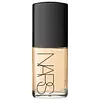What's inside
What's inside
 Key Ingredients
Key Ingredients

 Benefits
Benefits

 Concerns
Concerns

No concerns
 Ingredients Side-by-side
Ingredients Side-by-side

Water
Skin ConditioningCyclopentasiloxane
EmollientButylene Glycol
HumectantGlycerin
HumectantPolymethylsilsesquioxane
Dimethicone
EmollientTriethylhexanoin
MaskingPEG-10 Dimethicone
Skin ConditioningPolyglyceryl-3 Dimethicone
CleansingDisteardimonium Hectorite
StabilisingSodium Glutamate
MaskingSorbitan Sesquiisostearate
Emulsifying1-Methylhydantoin-2-Imide
Skin ConditioningPhenoxyethanol
PreservativeSodium Dehydroacetate
PreservativeTriethoxycaprylylsilane
Polysilicone-2
Serralysin
EmollientCurcumin
AntioxidantGlucosyl Hesperidin
HumectantAscorbyl Glucoside
AntioxidantTocopherol
AntioxidantCI 77891
Cosmetic ColorantCI 77492
Cosmetic ColorantCI 77491
Cosmetic ColorantCI 77499
Cosmetic ColorantWater, Cyclopentasiloxane, Butylene Glycol, Glycerin, Polymethylsilsesquioxane, Dimethicone, Triethylhexanoin, PEG-10 Dimethicone, Polyglyceryl-3 Dimethicone, Disteardimonium Hectorite, Sodium Glutamate, Sorbitan Sesquiisostearate, 1-Methylhydantoin-2-Imide, Phenoxyethanol, Sodium Dehydroacetate, Triethoxycaprylylsilane, Polysilicone-2, Serralysin, Curcumin, Glucosyl Hesperidin, Ascorbyl Glucoside, Tocopherol, CI 77891, CI 77492, CI 77491, CI 77499
Water
Skin ConditioningCyclopentasiloxane
EmollientButylene Glycol Dicaprylate/Dicaprate
EmollientTriethylhexanoin
MaskingIsoamyl Laurate
EmollientMethyl Trimethicone
Skin ConditioningPentylene Glycol
Skin ConditioningPolyglyceryl-4 Diisostearate/Polyhydroxystearate/Sebacate
EmulsifyingHydrogenated Starch Hydrolysate
HumectantCetyl PEG/PPG-10/1 Dimethicone
EmulsifyingTrimethylsiloxysilicate
EmollientSilica
AbrasivePerfluorooctyl Triethoxysilane
Aluminum Hydroxide
EmollientHydroxyacetophenone
AntioxidantSodium Chloride
MaskingDisteardimonium Hectorite
StabilisingDimethicone
EmollientAcrylates/Polytrimethylsiloxymethacrylate Copolymer
Skin Conditioning1,2-Hexanediol
Skin ConditioningCaprylyl Glycol
EmollientDimethicone/Vinyl Dimethicone Crosspolymer
Skin ConditioningTrisodium Ethylenediamine Disuccinate
Glycerin
HumectantCocos Nucifera Water
MaskingSodium Hyaluronate
HumectantCocos Nucifera Fruit Juice
EmollientRhododendron Ferrugineum Extract
MaskingPotassium Sorbate
PreservativeSodium Benzoate
MaskingCI 77891
Cosmetic ColorantIron Oxides
Water, Cyclopentasiloxane, Butylene Glycol Dicaprylate/Dicaprate, Triethylhexanoin, Isoamyl Laurate, Methyl Trimethicone, Pentylene Glycol, Polyglyceryl-4 Diisostearate/Polyhydroxystearate/Sebacate, Hydrogenated Starch Hydrolysate, Cetyl PEG/PPG-10/1 Dimethicone, Trimethylsiloxysilicate, Silica, Perfluorooctyl Triethoxysilane, Aluminum Hydroxide, Hydroxyacetophenone, Sodium Chloride, Disteardimonium Hectorite, Dimethicone, Acrylates/Polytrimethylsiloxymethacrylate Copolymer, 1,2-Hexanediol, Caprylyl Glycol, Dimethicone/Vinyl Dimethicone Crosspolymer, Trisodium Ethylenediamine Disuccinate, Glycerin, Cocos Nucifera Water, Sodium Hyaluronate, Cocos Nucifera Fruit Juice, Rhododendron Ferrugineum Extract, Potassium Sorbate, Sodium Benzoate, CI 77891, Iron Oxides
 Reviews
Reviews

Ingredients Explained
These ingredients are found in both products.
Ingredients higher up in an ingredient list are typically present in a larger amount.
Ci 77891 is a white pigment from Titanium dioxide. It is naturally found in minerals such as rutile and ilmenite.
It's main function is to add a white color to cosmetics. It can also be mixed with other colors to create different shades.
Ci 77891 is commonly found in sunscreens due to its ability to block UV rays.
Learn more about CI 77891Cyclopentasiloxane, or D5, is a silicone used to improve texture of products and trap moisture.
D5 is considered lightweight and volatile. Volatile means it evaporates quickly after application. Once evaporated, D5 leaves a thin barrier that helps keep skin hydrated.
It is also an emollient. Emollients help soften the skin and prevent water loss. Silicones create a silky texture in products. D5 helps other ingredients become more spreadable.
Studies show D5 is safe to use in skincare products. We recommend speaking with a skincare professional if you have concerns.
Learn more about CyclopentasiloxaneDimethicone is a type of synthetic silicone created from natural materials such as quartz.
What it does:
Dimethicone comes in different viscosities:
Depending on the viscosity, dimethicone has different properties.
Ingredients lists don't always show which type is used, so we recommend reaching out to the brand if you have questions about the viscosity.
This ingredient is unlikely to cause irritation because it does not get absorbed into skin. However, people with silicone allergies should be careful about using this ingredient.
Note: Dimethicone may contribute to pilling. This is because it is not oil or water soluble, so pilling may occur when layered with products. When mixed with heavy oils in a formula, the outcome is also quite greasy.
Learn more about DimethiconeDisteardimonium Hectorite comes from the clay mineral named hectorite. It is used to add thickness to a product.
It can also help stabilize a product by helping to disperse other ingredients.
Hectorite is a rare, white clay mineral.
Learn more about Disteardimonium HectoriteGlycerin is already naturally found in your skin. It helps moisturize and protect your skin.
A study from 2016 found glycerin to be more effective as a humectant than AHAs and hyaluronic acid.
As a humectant, it helps the skin stay hydrated by pulling moisture to your skin. The low molecular weight of glycerin allows it to pull moisture into the deeper layers of your skin.
Hydrated skin improves your skin barrier; Your skin barrier helps protect against irritants and bacteria.
Glycerin has also been found to have antimicrobial and antiviral properties. Due to these properties, glycerin is often used in wound and burn treatments.
In cosmetics, glycerin is usually derived from plants such as soybean or palm. However, it can also be sourced from animals, such as tallow or animal fat.
This ingredient is organic, colorless, odorless, and non-toxic.
Glycerin is the name for this ingredient in American English. British English uses Glycerol/Glycerine.
Learn more about GlycerinTriethylhexanoin is created from glycerin and 2-ethylhexanoic acid. It is a solvent and emollient.
As a solvent, Triethylhexanoin helps dissolve ingredients to stable bases or help evenly distribute ingredients throughout the product.
It is also an emollient and helps condition the skin.
Learn more about TriethylhexanoinWater. It's the most common cosmetic ingredient of all. You'll usually see it at the top of ingredient lists, meaning that it makes up the largest part of the product.
So why is it so popular? Water most often acts as a solvent - this means that it helps dissolve other ingredients into the formulation.
You'll also recognize water as that liquid we all need to stay alive. If you see this, drink a glass of water. Stay hydrated!
Learn more about Water